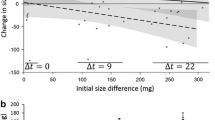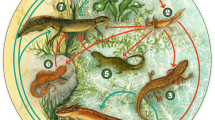Abstract
We investigated how size structure affects development of alternative larval phenotypes in Arizona tiger salamanders, Ambystoma tigrinum nebulosum, by testing the hypothesis that population size structure per se is a significant component of an individual's environment. Larvae of this subspecies exhibit one of two feeding phenotypes; typical larvae eat zooplankton and macroinvertebrates and cannibalistic larvae feed primarily on conspecifics. Previous laboratory experiments showed that larval density positively affected expression of the cannibalistic phenotype. In this study we tested the hypothesis that size variation among larvae also serves as a cue triggering development of the cannibalistic phenotype. We report laboratory experiments and field observations showing that both an individual larva's position in a size distribution and the amount of size vaiation among larvae serve as cues stimulating development of cannibalistic larvae. Larval density and population size structure provide a larva with an indication of the abundance and vulnerability of potential conspecific prey. Size variation among larvae, in turn, appears to be influenced by larval density. Thus, a complex relationship exists between larval density, population size structure, and the frequency of cannibals within a habitat.
Similar content being viewed by others
References
Begon M (1984) Density and individual fitness: asymmetric competition. In: Shorrocks B (ed) Evolutionary ecology. Blackwell, Oxford, pp 175–194
Collins JP, Cheek JE (1983) Effect of food and density of development of typical and cannibalistic salamander larvae in Ambystoma tigrinum nebulosum. Am Zool 23:77–84
Collins JP, Holomuzki JR (1984) Intraspecific variation in diet within and between trophic morphs in larval tiger salamanders (Ambystoma tigrinum nebulosum). Can J Zool 62:168–174
Collins JP, Zerba KE, Sredl MJ (1993) Shaping intraspecific variation: development, ecology and the evolution of morphology and life history variation in tiger salamanders. Genetica 89:167–183
Dodson SI (1970) Complementary feeding niches sustained by size-selective predation. Limnol Oceanogr 15:131–137
Dong Q, Polis GA (1992) The dynamics of cannibalistic populations: a foraging perspective. In: Elgar MA, Crespi BJ (eds) Cannibalism: ecology and evolution among diverse taxa. Oxford University Press, Oxford, pp 13–37
Ebenman B, Persson L (1988) Size-structured populations: ecology and evolution. Springer, Berlin Heidelberg New York
Hutchingson GE (1957) Concluding remarks. Cold Spring Harbor Symp Quant Biol 22:415–427
Keast A (1977) Mechanisms expanding niche width and minimizing intraspecific competition in two centrarchid fishes. Evol Biol 10:333–395
Kingsolver JG, Paine RT (1991) Theses, antitheses, syntheses. In: Real LA, Brown JH (eds) Foundations of ecology: classic papers with commentaries. University of Chicago Press, Chicago, pp 309–317
Krebs JR, Davies NB (1984) Behavioral ecology. Blackwell, Oxford
Lima SL, Dill LM (1990) Behavioral decisions made under the risk of predation: a review and prospectus. Can J Zool 68:619–640
Loeb MLG (1991) Ecology and evolution of alternative larval phenotypes in the Arizona tiger salamander. M.S. Thesis, Arizona State University
Loeb MLG, Collins JP, Maret TJ (1994) The role of prey in controlling expression of a trophic polymorphism in Ambystoma tigrinum nebulosum. Funct Ecol 8:151–158
Lomnicki A (1988) Population ecology of individuals. Princeton University Press, Princeton
Mittelbach GG, Osenberg CW, Leibold MA (1988) Trophic relations and ontogenetic niche shifts in aquatic ecosystems. In: Ebenman B, Persson L (eds) Size-structured populations: ecology and evolution. Springer, Heidelberg Berlin New York, pp 219–235
Neill WE (1988) Community responses to experimental nutrient perturbations in oligotrophic lakes: the importance of bottlenecks in size-structured populations. In: Ebenman B, Persson L (eds) Size-structured populations: ecology and evolution. Springer, Berlin Heidelberg New York, pp 236–255
Ohlandt G (1992) Microgeographic variation in life history of Ambystoma tigrinum nebulosum in Arizona. M.S. Thesis, Arizona State University
Pedersen SC (1991) Dental morphology of the cannibal morph in the tiger salamander, Ambystoma tigrinum. Amphibia-Reptilia 12:1–14
Persson L (1988) Asymmetries in competitive and predatory interactions in fish populations. In: Ebenman B, Persson L (eds) Size-structured populations: ecology and evolution. Springer, Berlin, Heidelberg New York, pp 203–218
Pfennig DW, Loeb MLG, Collins JP (1991) Pathogens as a factor limiting the spread of cannibalism in tiger salamanders. Oecologia 88:161–166
Reilly SM, Lauder GV, Collins JP (1992) Performance consequences of a trophic polymorphism: Feeding behavior in typical and cannibal phenotypes of Ambystoma tigrinum. Copeia 1992:672–679
Roughgarden J (1972) Evolution of niche width. Am Nat 106:983–718
Smith TB (1987) Bill size polymorphism and intraspecific niche utilization in an African finch. Nature 329:717–719
Snedecor GW, Cochran WG (1967) Statistical methods. Iowa State University Press, Ames
Sokal RR, Rohlf FJ (1981) Biometry, Freeman, New York
Van Valen L (1965) Morphological variation and width of ecological niche. Am Nat 99:377–390
Werner EE (1992) Individual behavior and higher-order species interactions. Am Nat 140:S5-S32
Werner EE, Gilliam JF (1984) The ontogenetic niche and species interactions in size-structured populations. Annu Rev Ecol Sys 15:393–425
West-Eberhard MJ (1989) Phenotypic plasticity and the origins of diversity. Annu Rev Ecol Syst 20:249–278
Wilbur HM, Fauth JE (1990) Experimental aquatic food webs: interactions between two predators and two prey. Am Nat 135:176–204
Wilkinson L (1992) SYSTAT for the Macintosh, version 5.2. Systat, Evanston
Wissinger SA (1989) Seasonal variation in the intensity of competition and predation among dragonfly larvae. Ecology 70:1017–1027
Zaret TM (1980) Predation and freshwater communities. Yale University Press, New Haven
Author information
Authors and Affiliations
Rights and permissions
About this article
Cite this article
Maret, T.J., Collins, J.P. Individual responses to population size structure: the role of size variation in controlling expression of a trophic polyphenism. Oecologia 100, 279–285 (1994). https://doi.org/10.1007/BF00316955
Received:
Accepted:
Issue Date:
DOI: https://doi.org/10.1007/BF00316955




